

Beguines and Beghards. A drawing of a Beguine from Des dodes dantz, printed in Lübeck in 1489.
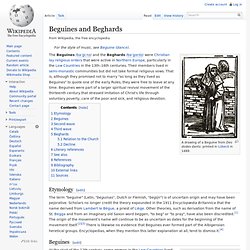
The Beguines /bəˈɡiːnz/ and the Beghards /bəˈɡɑrdz/ were Christian lay religious orders that were active in Northern Europe, particularly in the Low Countries in the 13th–16th centuries. Their members lived in semi-monastic communities but did not take formal religious vows. That is, although they promised not to marry "as long as they lived as Beguines" to quote one of the early Rules, they were free to leave at any time.
Beguines were part of a larger spiritual revival movement of the thirteenth century that stressed imitation of Christ's life through voluntary poverty, care of the poor and sick, and religious devotion. Etymology[edit] The term "beguine" (Latin, "beguinas'', Dutch or Flemish, "begijn") is of uncertain origin and may have been pejorative. Beguines[edit] Brethren of the Free Spirit. The Brothers, or Brethren of the Free Spirit, was a lay Christian movement which flourished in northern Europe in the 13th and 14th centuries.
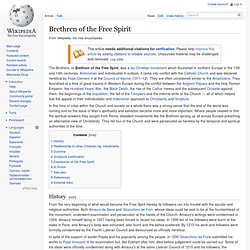
Antinomian and individualist in outlook, it came into conflict with the Catholic Church and was declared heretical by Pope Clement V at the Council of Vienne (1311–12). They are often considered similar to the Amalricians. Catharism. Christian dualist movement that thrived in some areas of Southern Europe Catharism (; from the Greek: καθαροί, katharoi, "the pure [ones]")[2] was a Christian dualist or Gnostic movement between the 12th and 14th centuries which thrived in Southern Europe, particularly what is now northern Italy and southern France.

Followers were known as Cathars, or Good Christians, and are now mainly remembered for a prolonged period of persecution by the Catholic Church, which did not recognise their unorthodox Christianity. John Wycliffe. Wycliffe was also an early advocate for translation of the Bible into the common language.
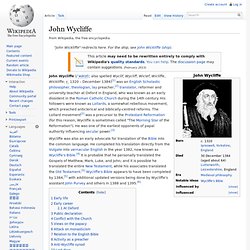
He completed his translation directly from the Vulgate into vernacular English in the year 1382, now known as Wycliffe's Bible.[4] It is probable that he personally translated the Gospels of Matthew, Mark, Luke, and John; and it is possible he translated the entire New Testament, while his associates translated the Old Testament.[5] Wycliffe's Bible appears to have been completed by 1384,[5] with additional updated versions being done by Wycliffe's assistant John Purvey and others in 1388 and 1395.[6] Early life[edit] John Wycliffe.
Lollardy. In this 19th-century illustration, John Wycliffe is shown giving the Bible translation that bore his name to his Lollard followers.
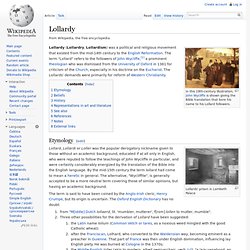
Lollardy (Lollardry, Lollardism) was a political and religious movement that existed from the mid-14th century to the English Reformation. The term "Lollard" refers to the followers of John Wycliffe,[1] a prominent theologian who was dismissed from the University of Oxford in 1381 for criticism of the Church, especially in his doctrine on the Eucharist. The Lollards' demands were primarily for reform of Western Christianity.
Etymology[edit] Lollards' prison in Lambeth Palace. Waldensians. Waldensians. Waldensians, Waldenses, Vallenses[1] or Vaudois are names for a Christian movement which started in Lyon and spread soon to the Cottian Alps in the late 1170s.

The movement, named after founder Peter Waldo, advocated an adherence to the Gospel that led to conflicts with the Roman Catholic Church. Jan Hus. Jan Hus (Czech pronunciation: [ˈjan ˈɦus] ( ); c. 1369 – 6 July 1415), often referred to in English as John Hus or John Huss, was a Czech priest, philosopher, reformer, and master at Charles University in Prague.
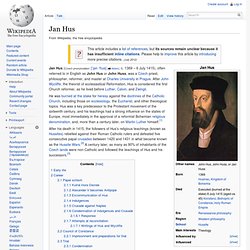
Moravian Church. This page is about the Moravian Church globally.
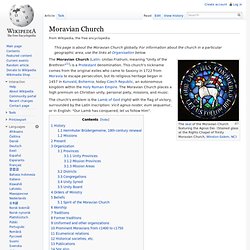
For information about the church in a particular geographic area, use the links at Organisation below. The Moravian Church (Latin: Unitas Fratrum, meaning "Unity of the Brethren"[1]) is a Protestant denomination. This church's nickname comes from the original exiles who came to Saxony in 1722 from Moravia to escape persecution, but its religious heritage began in 1457 in Kunvald, Bohemia, today Czech Republic, an autonomous kingdom within the Holy Roman Empire. Taborite. The Taborites (Czech Táborité, singular Táborita) were members of a religious community considered heretical by the Catholic Church.
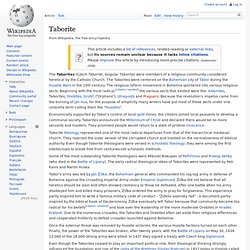
German mysticism. German mysticism, sometimes called Dominican mysticism or Rhineland mysticism, was a late medieval Christian mystical movement, that was especially prominent within the Dominican order and in Germany.

Although its origins can be traced back to Hildegard of Bingen, it is mostly represented by Meister Eckhart, Johannes Tauler, and Henry Suso. Other notable figures include Rulman Merswin and Margaretha Ebner, and the Friends of God. Some of the movement's characteristics: A focus on laymen as well as clericsAn emphasis on instruction and preachingDownplaying ascetismA focus on the New Testament rather than the Old TestamentA focus on the Christ rather than the Church[citation needed]A use of the vernacular (German and Dutch) rather than Latin or Hebrew Some in the movement came under criticism by the Church for heterodox or heretical opinions.
It influenced the following Protestant Reformation, as well as philosophers such as Schopenhauer[citation needed] and Wittgenstein[citation needed].